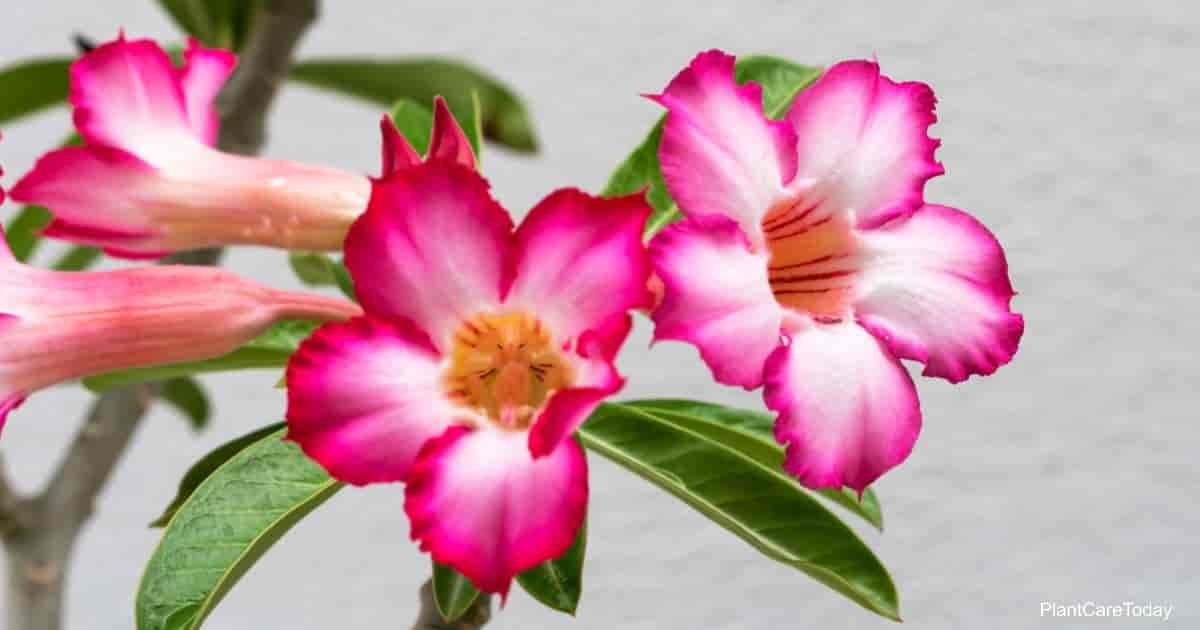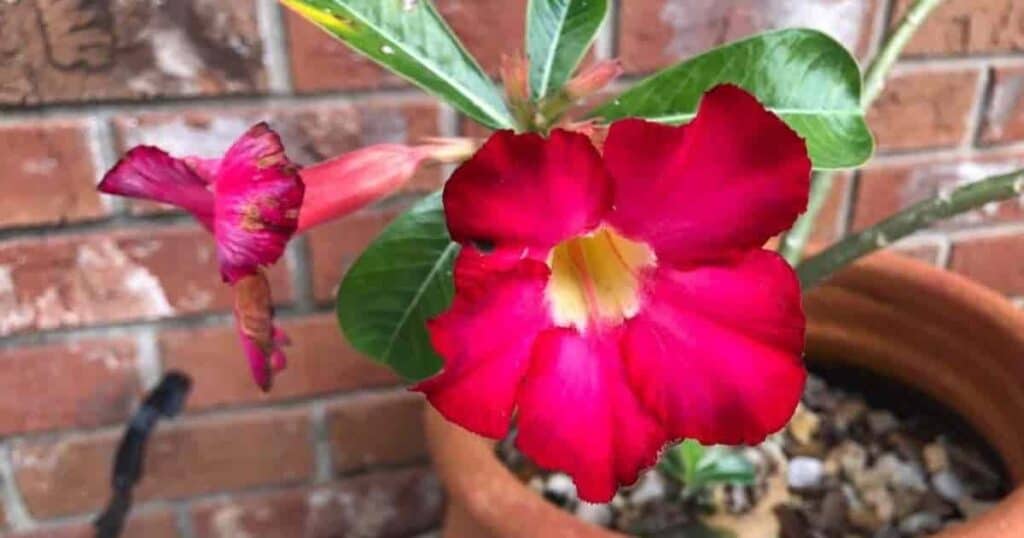The Adenium plant, or Desert Rose, is a member of the dogbane family, Apocynaceae. They feature thick succulent trunks, a bulging caudex, shiny green leaves, and bright pink flowers.
The plant is low-maintenance in nature and can thrive with minimal attention. Fertilizing promotes healthy growth and beautiful blooms. Feeding the desert rose makes sure it gets the vital nutrients it needs.

Key Takeaways
- Desert Roses don’t require a lot of fertilizer, but a balanced fertilizer is beneficial.
- A well-balanced water-soluble or slow-release fertilizer can provide essential NPK nutrients (Nitrogen, Phosphorus, and Potassium).
- To encourage growth and blooming, Desert Rose plants respond well to phosphorus-rich fertilizers like bone meal fertilizer.
- A fertilizer rich in potassium and phosphorus promotes flowering while improving the color and duration of the blooms.
- Adeniums require little water or fertilizer during winter dormancy. A diluted fertilizer once a month is beneficial.
- During spring and summer, when the plant flowers, increase fertilizing.
What is the Best Fertilizer for Desert Rose?
From what I’ve seen, the best fertilizer for Desert Rose plants is a light-feeding of balanced fertilizer.
Feed using a balanced, water-soluble fertilizer or a slow-release fertilizer. Adeniums respond well to phosphorus-rich fertilizers, such as bone meal.
What is the best type of fertilizer for Adenium to bloom? A fertilizer high in potassium and phosphorus will encourage your plant to produce lots of flowers.
It also makes the flowers have brighter colors and last longer. For liquid desert rose food, we like a 10-30-20 NPK ratio.
Fertilizing Desert Rose Plants
In the winter, Desert rose bunnings rest, or ‘sleep,’ and don’t need much water or food. If you want, you can give them a weak fertilizer mix once a month.
Once the roots become established, a healthy Adenium displays lovely flowers in the spring and summer. The plant needs extra fertilizer during these seasons to support all its blooming.
In the early spring, give your plants a balanced slow-release fertilizer. When you move them to a new pot, add it to the potting soil when transplanting.
Many Adenium lovers suggest feeding with a water-soluble liquid fertilizer. But only feed at half the strength listed on the label.
Feed regularly (every 2 weeks) while the plants are growing new leaves and flowers.
Before You Apply Adenium Fertilizer In Spring
When spring comes, it’s a good time to think about moving your plants to a new pot before new leaf growth begins.
Before you repot, and as part of caring for your plant, always look for bugs or pests. Spider mites or mealy bugs might have made a home in your plant during the winter.
- Spray with insecticidal soap or Neem oil for control.
- Prune out any dead wood, broken branches, or stems needed to maintain shape.
- Watch out for aphids who love to lunch on tender new growth as new growth begins.
Fertilizing Desert Rose When Transplanting
When repotting or transplanting desert rose Adenium, use a cactus or succulent soil mix.
You can add a bit of perlite to help improve drainage. Always choose a pot or container with drainage holes to prevent root rot.
The thick base of the Desert Rose, which we call a ‘caudex,’ looks great when planted in a special shallow bonsai pot.
As mentioned above, desert roses like a little extra phosphorus. Mix some bone meal into the potting mix before repotting.
If your Adenium does not need repotting, top dress with some bone meal (1 tsp) and lightly water it into the soil.
If you enjoy DIY, you should learn about homemade adenium plant fertilizer recipes.
When making a homemade desert rose fertilizer, ensure it is low in nitrogen and high in phosphorus to promote healthy flowering.
High nitrogen fertilizer can cause the Adenium to develop too much foliage.

When Should You Use a High Nitrogen Fertilizer?
Fertilizers high in nitrogen promote leafy growth. But it can also stop flower buds from forming. Extra nitrogen is useful at certain stages in a Desert Rose’s growth.
When starting plants from seeds or branch cuttings, nitrogen helps produce more foliage and roots. A good-quality fertilizer for adenium plants with extra nitrogen helps increase the success of propagation.
Adeniums need a balanced fertilizer for healthy growth and blooming. Be careful when using a fertilizer with a lot of nitrogen.
Homemade Fertilizer Recipes
Common homemade fertilizer for desert rose recipes include:
- A mixture of bone meal, blood meal, and superphosphate. Follow the recommended rates on the label.
- Another recipe uses a balanced 10-10-10 fertilizer, with additional phosphorus from bone meal or rock phosphate.
It is important to avoid over-fertilizing Adenium plants. Overfertilizing can lead to salt buildup and damage to the roots.
The best time to feed your Desert Roses is when they are growing new leaves and flowers – usually from spring to fall.
NOTE: Desert Rose contains toxic sap that can cause skin irritation. Wear gloves when handling the plant.
Desert Rose Growing Tips
- Adenium obesum grown in direct sun will perform best
- Use a well-draining potting soil – not garden soil
- Check for pests (spider mites, mealy bugs, and aphids)
- No overwatering can lead to root rot – allow the soil to dry out before watering again.
- Fertilize using a slow-release fertilizer
- Incorporate bone meal for extra phosphorus
- Supplement during the growing season with half-strength liquid fertilizer
- Enjoy the beautiful flowers in the garden. Bloom frequency varies.
Adenium Desert Roses: Origin, Common Names, and More
Adenium, or Desert Rose, belongs to the genus Adenium and is closely related to the Dipladenia species. They love the sun and look great as bonsai trees. Their natural habitats are Madagascar, the Sahel regions, Southern Africa, south of the Sahara, and Southern Arabia.
The Desert Rose plant is known for its pink-red flowers. Thanks to plant breeding, Adenium flowers come in many bright colors like yellow, pink, purple, deep red, orange, and white.
The Adenium comes from many places and is popular in many cultures. It goes by many names:
- Mock Azalea
- Sabi Star
- Impala Lily
- Dwarf Bottle Tree
Desert Rose plants can thrive in various environments. These plants need well-draining soil, lots of water, and plenty of sunlight for optimal growth.
Selecting the right fertilizer depends on weather conditions and the growing environment.
- Adeniums love hot climates. They stay healthy and strong all year in full sunlight and warm weather.
- Desert rose plants prefer full sun and 70° degrees Fahrenheit (21° C) or higher temperatures.
- Adenium flowers attract hummingbirds and pollinators like butterflies and bees.
Closing Care And Desert Rose Fertilizer Tips
Best Fertilizer for Adenium: Desert Roses don’t need much fertilizer. They benefit from a well-balanced, water-soluble, or slow-release fertilizer. Phosphorus-rich fertilizers, like bone meal, promote growth and flowering.
Fertilizing Schedule: Desert Roses enter dormancy in winter, requiring little water or fertilizer. Apply a diluted fertilizer once a month during this time. Plants experience their most active growth and blooming stages in spring and summer. It is important to increase the frequency of fertilization.
Pre-Fertilizing Care: Before starting fertilization in spring:
- Consider repotting the plant.
- Inspect for pests like spider mites or mealybugs. Treat infestations with insecticidal soap or Neem oil.
- Prune dead wood or broken branches to maintain plant shape.
Potting and Planting: When repotting or transplanting, use a cactus or succulent soil mix. Add extra perlite or pumice for better drainage. Always choose a container with drainage holes to avoid root rot. Mix bone meal into the potting mix for extra phosphorus.
Extra Growth Tips: Desert Roses flourish in direct sunlight and well-draining potting soil. Avoid overwatering these succulent plants. Let the soil dry before watering again. During the growing season, apply half-strength water-soluble liquid fertilizer monthly.